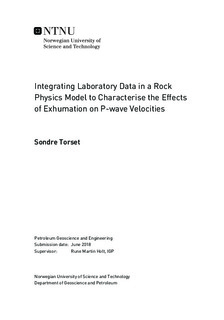Integrating Laboratory Data in a Rock Physics Model to Characterise the Effects of Exhumation on P-wave Velocities
Master thesis
Permanent lenke
http://hdl.handle.net/11250/2561547Utgivelsesdato
2018Metadata
Vis full innførselSamlinger
Sammendrag
Rocks have memory. The characteristics measured by seismic, wireline or in laboratory tests on cores depend on the historythat brought the rock to its current state. The burial history is also a controlling factor on elements such as the maturation ofhydrocarbons and reservoir quality. Identification, quantification and characterisation of any uplift a rock has been subjected to inorder to reach its current depth is therefore an important aspect in interpretation and risking in the oil and gas industry.Several methodologies exist to accomplish the goal of characterisation of uplift. The focus of this thesis is sandstone modelling.Currently applied procedures for the estimation of uplift from such a strategy is based on the assumption that as the rock isuplifted out of the cementation domain, the properties are unchanged during continued exhumation.Experimental data from SINTEF showed that whilst the assumption of no change might be good for porosity, for a relativelyweakly cemented synthetic sandstone formed under simulated in-situ stress, there was a dramatic increase in stress dependence ofthe velocity upon simulated uplift under uniaxial strain conditions. In addition to this increased stress dependence, the P-waveanisotropy was reversed upon sufficient simulated uplift. The main goal of this work was to incorporate these observations intoan updated rock physics model for characterising the effects of uplift.In previous work (Torset, 2017) one interpretation of the observations regarding velocity and P-wave anisotropy was theformation of microcracks as a result of broken cement bonds, with normals preferentially oriented parallel to the axial direction.The uplift interval has therefore been modelled with the crack model presented in Fjær (2006).To implement a full burial history calibrated to the experimental data, models capable of recreating the experimental data downto the onset of uplift are also needed. Before cementation, the model provided in Walton (1987) is used. Instead of using theexplicit expressions given in Walton (1987), the general equations for strain and stiffness have been solved for a particular triaxialstrain state, namely that the horizontal strains are equal.The experimental data displayed both anisotropy and stress dependence after cementation. To account for this, a modifiedversion of the patchy cement model presented in Avseth et al. (2016) has been utilised. The modification came from using ananisotropic granular media with an anisotropic formulation of the Hashin-Shtrikman bounds, as opposed to the isotropic varietiesimplemented in Avseth et al. (2016).Sowing together the three models enabled for a very good recreation of the experimental P-wave velocities as function ofthe simulated burial history. After calibration to the experimental data the model is implemented in combination with a cementestimation model (Walderhaug, 1996) to produce a model capable of taking in a real burial history.The ability of the model to fit the data is not taken as validity of the model. The final rock physics model developed forcharacterising the uplift is dependent on the assumptions of the underlying models, the method of implementation and a widevariety of parameters that are available to facilitate fitting to the experimental data. The quantitative nature of the final modelis therefore uncertain. This statement is however not unique to the model in this work, as most rock physics models aiming tocharacterise velocity as function of burial history suffer generalisations and depend on the choice of parameters such as the elasticparameters of the grain material.Analysis of additional experimental data suggests that the effects of the uplift might be reduced in the case of a very stiff rock(corresponding to a lot of cement). In such a scenario, uplift modelling by assuming no change in parameters might be moreappropriate.The effect of fluids were modelled by the isotropic Biot-Gassmann equation. The effects of increased stress dependence onthe velocities and P-wave anisotropy were reduced, but under sufficient unloading a reversal in the P-wave anisotropy was stillobserved
